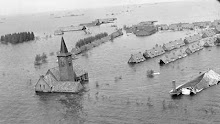Aden: breeding of Swift Terns
Life list now 216 species
On 1 June 1946 I noticed a new species of tern of which there was a flock of about 25. At first I could not name it but later identified it as the Swift Tern* Sterns bergii. On 10 July I estimated about 200 of these birds in two flocks on large pools where there was exposed mud. A flock remained in one of the pools (c. 400 by c. 500 metres) and numbered c.80 on 22 July and c.60 on 28 July. Then, on 4 August, in the same pool, I found the water level higher, all but three of the terns gone, but 37 eggs along the east side. “They were all either floating or lying on exposed mud at the edge. The wind was blowing strongly from the west (as usual) and I suspect that the eggs had been blown across the surface from a colony of Swift Terns nests in the centre of the pool. I have seen the species there in numbers not less than 60 for a month or two.
>>>
There were 15 eggs in one corner. 8 had white grounds, 3 pinkish stone (paler than III) and one ordinary stone. Spots on the latter were very small, like the egg of a Coot [Fulica atra]. I was able to retrieve three eggs (which seemed representative), sketch and measure them. I also took down the following descriptions.
I: ground colour white; spots mixed medium and very dark rich brown; a few medium to pale grey.
II: ground colour white, spots mostly medium to dark brown, the majority having grey edging.
III: ground colour fairly pale pinkish stone, spotted as in I but browns redder and greys bluer.
In all three, the surfaces were matt. When broken, I and III revealed respectively a clear red ball (yolk?) and an opaque orange mass; II was practically empty.”
Barnes (1893) has a similar description of Swift Terns eggs. His average size was 62 x 43 mm; mine 63 x 43 mm.
*Description on 1 June 1946: “Most noticeable feature at a distance on the ground was the contrast of white neck with dark body. At shorter range it was possible to see that the crown was very black; this rather crested cap extended to the nape in some some cases. The back, rump, upper tail and upper wing surfaces were quite dark grey or grey-brown appearing darkest on the primaries and lightest on the upper tail. In flight this dark plumage was much less noticeable. The neck and underparts seemed white. Bill: long, slightly down-curved and yellowish, feet and legs black or very dark. Their size was about equal or a little less than that of the Caspian Tern, the flight rather resembled that of this species. The call heard once or twice when one bird was disturbed by another was a very harsh “ark-ark”, quite unlike the quaver of the Caspian Tern.” On 10 July 1946 I described the call: “resembles that of a breeding Black-headed Gull [Larus rhidibundus, which call I knew from England] only more grating.July 20, 2010.”
Subscribe to:
Comments (Atom)



